#could also be between ultraviolet and x rays
Explore tagged Tumblr posts
Text
I wonder if darkners were viewed with infrared, would they look like objects or like themselves....
#going post#deltarune#utdr#deltarune spoilers#but only in the tags#anyway like. so the idea is that the absence of all light is “taken away” as in it gets darker than dark#and red/orange is the lowest temperature we can see with fire. while blue/violet is the highest#(and i know it doesnt track like this but im trying 2 put real science on a fictional concept so bear with me)#so red is kind of like the least bright form of light. meaning its the darkest.#so then could darker than dark be infrared?#....... but also infrared is made of photons too. and gasters entry 17 said photon readings NEGATIVE#(impossible irl but again. fiction)#meaning that itd be emenating Darkness not light. so not even infrared or ultraviolet#so then. maybe darkworlds are kind of inbetween infrared and microwaves#like. a secret room between rooms. like how you find gasters door in ut or the egg man in dr#could also be between ultraviolet and x rays#bc im not a scientist and i dont know what im talking abt lol. so maybe red is actually the brightest even if its not the hottest!#it goes cosmic rays at the shortest end > gamma rays > x rays > uv > visible light > infrared > microwaves > radar > radio > broadcast bands#at the longest wavelength#and imo dark worlds being closer to COSMIC RAYS sounds way cooler
6 notes
·
View notes
Text
Reconceptualising the colours in Stranger Things
Currently (I could have my mind changed in the future) my understanding is that Jane/Eleven, Will, and Mike at their core are generally associated with 1 colour each Red, Yellow, and Blue respectively
Following is an excerpt from chat GPT;
“Electromagnetic Spectrum
The electromagnetic spectrum encompasses all types of electromagnetic radiation, arranged according to their frequency or wavelength. The main categories include:
Radio Waves:
Wavelength: > 1 mm
Frequency: < 300 GHz
Uses: Communication (radio, television), astronomy, MRI
Microwaves:
Wavelength: 1 mm to 1 cm
Frequency: 300 MHz to 300 GHz
Uses: Microwave ovens, radar, satellite communication
Infrared (IR):
Wavelength: 700 nm to 1 mm
Frequency: 300 GHz to 430 THz
Uses: Remote controls, thermal imaging, night vision
Visible Light:
Wavelength: 400 nm to 700 nm
Frequency: 430 THz to 770 THz
Colors: Red (longest wavelength) to violet (shortest wavelength)
Ultraviolet Light:
Wavelength: 10 nm to 400 nm
Frequency: 750 THz to 30 PHz
Uses: Sterilization, fluorescent lamps, UV curing
X-Rays:
Wavelength: 0.01 nm to 10 nm
Frequency: 30 PHz to 30 EHz
Uses: Medical imaging, security, astronomy
Gamma Rays:
Wavelength: < 0.01 nm
Frequency: > 30 EHz
Uses: Cancer treatment, sterilization, nuclear physics”
Make of that as you will, please share your thoughts if you have any before continuing to read.
But for me I think about the full spectrum of colours we can see are obviously very limited. If we were able to perceive all of this spectrum, I image it is just purely more nuance and distinguishing between these levels. So imagine we could distinguish and our perception wasn’t so limited. Radio waves- Gamma rays represents a spectrum from red to violet (red, orange, yellow, green (maybe cyan), blue, (maybe indigo), violet… I notice that Jane has been since the start of the show associated with radio, television. I think this is giving us the key to understand the other characters like Will and Mike… Will has already been hinted at being in control of some characters in a way and I think this is also how the Mind Flayer achieved control of Will by stealing his power and using it against him. Now Mike is interesting because his colour could be UV a symbol for something beyond human perception in a way beyond sight (like emotion - “you’re the heart” OR or X-Rays a possible symbol for the ability to see through something…
what do you think?
14 notes
·
View notes
Text
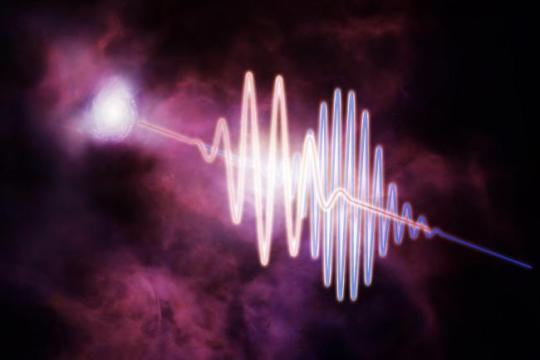
A New GPS for the Intergalactic Medium: Astronomers Have Found the Home Address for Universe's "Missing" Matter
Using fast radio bursts to guide them, CfA astronomers have mapped the distribution of the Universe's ordinary matter in the space between galaxies, and detected the most distant fast radio bursts to date.
A new landmark study has pinpointed the location of the Universe's "missing" matter, and detected the most distant fast radio burst (FRB) on record. Using FRBs as a guide, astronomers at the Center for Astrophysics | Harvard & Smithsonian (CfA) and Caltech have shown that more than three-quarters of the Universe's ordinary matter has been hiding in the thin gas between galaxies, marking a major step forward in understanding how matter interacts and behaves in the Universe. They’ve used the new data to make the first detailed measurement of ordinary matter distribution across the cosmic web.
For decades, scientists have known that at least half of the Universe's ordinary, or baryonic matter—composed primarily of protons—was unaccounted for. Previously, astronomers have used techniques including X-ray emission and ultraviolet observations of distant quasars to find hints of vast amounts of this missing mass in the form of very thin, warm gas in between galaxies. Because that matter exists as hot, low-density gas, it was largely invisible to most telescopes, leaving scientists to estimate but not confirm its amount or location.
Enter FRBs— brief, bright radio signals from distant galaxies that scientists only recently showed could measure baryonic matter in the Universe, but until now could not find its location. In the new study, researchers analyzed 60 FRBs, ranging from ~11.74 million light years away—FRB20200120E in galaxy M81—to ~9.1 billion light years away—FRB 20230521B, the most distant FRB on record. This allowed them to pin down the missing matter to the space between galaxies, or the intergalactic medium (IGM).
"The decades-old 'missing baryon problem' was never about whether the matter existed," said Liam Connor, CfA astronomer and lead author of the new study. "It was always: Where is it? Now, thanks to FRBs, we know: three-quarters of it is floating between galaxies in the cosmic web." In other words, scientists now know the home address of the “missing” matter.
By measuring how much each FRB signal was slowed down as it passed through space, Connor and his team tracked the gas along its journey. "FRBs act as cosmic flashlights," Connor, who is also an assistant professor of astronomy at Harvard, said. "They shine through the fog of the intergalactic medium, and by precisely measuring how the light slows down, we can weigh that fog, even when it's too faint to see."
The results were clear: Approximately 76% of the Universe's baryonic matter lies in the IGM. About 15% resides in galaxy halos, and a small fraction is burrowed in stars or amid cold galactic gas.
This distribution lines up with predictions from advanced cosmological simulations, but has never been directly confirmed until now.
"It's a triumph of modern astronomy," said Vikram Ravi, an assistant professor of astronomy at Caltech and co-author of the paper. "We're beginning to see the Universe's structure and composition in a whole new light, thanks to FRBs. These brief flashes allow us to trace the otherwise invisible matter that fills the vast spaces between galaxies."
Finding the missing baryons isn’t just an exercise in building an address book or taking a census. Their distribution holds the key to unlocking deep mysteries about how galaxies form, how matter clumps in the Universe, and how light travels across billions of light-years.
"Baryons are pulled into galaxies by gravity, but supermassive black holes and exploding stars can blow them back out—like a cosmic thermostat cooling things down if the temperature gets too high," said Connor. "Our results show this feedback must be efficient, blasting gas out of galaxies and into the IGM."
And this is just the beginning for FRB cosmology. "We're entering a golden age," said Ravi, who also serves as the co-PI of Caltech’s Deep Synoptic Array-110 (DSA-110). "Next-generation radio telescopes like the DSA-2000 and the Canadian Hydrogen Observatory and Radio-transient Detector will detect thousands of FRBs, allowing us to map the cosmic web in incredible detail."
The study is published today in Nature Astronomy.
IMAGE: A landmark study led by the Center for Astrophysics | Harvard & Smithsonian (CfA) has pinpointed the Universe’s “missing” matter using Fast Radio Bursts (FRBs)— brief, bright radio signals from distant galaxies— as a guide. This artist’s conception depicts a bright pulse of radio waves (the FRB) on its journey through the fog between galaxies, known as the intergalactic medium. Long wavelengths, shown in red, are slowed down compared to shorter, bluer wavelengths, allowing astronomers to “weigh” the otherwise invisible ordinary matter. Credit: Melissa Weiss/CfA
4 notes
·
View notes
Text
A Tsunami of Solar Storms: A Call for Unity from ALLATRA

The world is alarmed: a "tsunami of solar storms" has hit Earth. This is not just a cosmic phenomenon; it is a signal that our planet is in danger.
## The Sun in the Deadly Grip of a Cosmic Cycle
In 2024, a new 12,000-year cosmic cycle began, and the Sun has become unpredictable. C and M class flares, plasma eruptions, coronal mass ejections - all of these threaten our planet. Earth's magnetic field, our natural shield, is weakening, and we are becoming more vulnerable to cosmic threats.
On Thursday, August 1, 2024, various regions of the planet experienced problems with radio communications caused by the tsunami of solar storms. Over a 24-hour period, the Sun produced 15 flares of varying intensity in the C and M classes.
Eruptions of ultraviolet and X-ray radiation, along with energy release, occurred in several sunspots. The most active spot was AR3774, where 9 flares occurred!
As a reminder, flares are categorized into 5 classes. The most powerful is class X, and the weakest is class A. Classes C and M are the second and third strongest in this list.
All 15 flares were reportedly accompanied by plasma eruptions or coronal mass ejections.
Space weather experts stated that the Sun's recent activity constitutes a "tsunami of solar storms."
The radiation streams reached Earth in minutes, disrupting radio communications in parts of Africa and Asia. However, such solar strikes can also disrupt the operation of satellites in orbit, as well as GPS systems on Earth.
Scientists from NOAA predict that plasma streams could reach Earth on Saturday, August 3, or Sunday, August 4. The impact of plasma on Earth's magnetic field could lead to G2-level geomagnetic storms.
Scientists forecast a new series of M-class flares on the Sun between August 2 and 4. There is also a chance of X-class flares occurring.
These flares may also occur with plasma eruptions, which could trigger a geomagnetic storm on Earth as early as the beginning of next week.
## The Climate Crisis Is More Than Just Weather
Solar storms are just one of many symptoms of the climate crisis. Changes in space affect Earth's climate, causing unpredictable weather events and disasters. We are seeing this with our own eyes: landslides, floods, droughts, hurricanes - all of these are becoming more frequent and dangerous.
## ALLATRA International Public Movement: Saving the Planet Is Our Shared Responsibility
ALLATRA, a global social movement, calls for unity in the face of this threat. We must unite humanity's scientific potential in a single scientific center and find solutions to protect the planet from solar storms and other cosmic threats.
## Time to Act Now
We cannot afford to simply observe. We need to act together, share information and resources, and develop new technologies to save Earth. Each of us can contribute to solving this global problem.
Let us work together to create a future for our planet!
This is extremely important information, please be sure to share it, write a comment, like, repost, and of course, give a round of applause!!!
#ALLATRA #ClimateCrisis #CreativeSociety #Technology #UnitedScientificCenter
0 notes
Text
Why don't demons burn/feel irritated in the moonlight?
Asked by @/echantedtoon // Oh wow.. This is a very interesting perspective that I had never really thought about before xd! I pondered about this for a bit and came up with two reasonable explanations.. I couldn't decide between them, nor could I think of anything else, so you're welcome to dive into either option. And please, don’t hesitate to share any other insights or corrections you might have! <33

THEORETICAL EXPLANATION
1] So one potential explanation could be that the demons may have adapted to the limited exposure to sunlight.
2] Alternatively, as you suggested, the demons might actually be feeling irritated from the sunlight reflecting off the moon.[And although this is not explicitly mentioned in the manga itself, it is pretty reasonable to speculate that such a phenomenon could be occurring]
--For the irritation to affect the demons, there must be a source of that discomfort, implying that the moonlight could be causing them minor harm, albeit with their regeneration occurring rapidly enough to counteract it.

Also, a repeated trauma to their bodies like this must actually constantly hinder their healing process, albeit temporarily. This also indirectly suggests that moonlight has varying effects on demons based on their strength—the stronger ones have greater immunity, while weaker ones not so much, which would result in their weaker and slower regeneration, as most of the energy is spent on already regenerating the damage caused by the moon.
[Also, the fact that even the moon seems to work out of favor against demons just truly shows how much they're completely out of bounds with nature.. lol]
But again, these are demons we are talking about—their inherent strength and regenerative capabilities might only be the result of Muzan's blood rather than the moonlight itself. Nonetheless, it is a fascinating concept to ponder.

A MORE PRACTICAL EXPLANATION
Shifting our focus away from the demons for a moment, let's consider the roles of sunlight and moonlight:
▪︎All of the energy emitted by the Sun that reaches our planet is in the form of solar radiation, consisting of visible light, ultraviolet light, infrared radiation, radio waves, X-rays, and gamma rays. Radiation is one way to transfer heat. Among these, we know UV rays are the ones that cause us sunburns.
[Though, unlike UV rays, it is the infrared energy that actually provides all the 'heat' energy, and we can also see that the demons might be literally burning in the sun, one could also assume it might be more because of the thermal radiation. However, since we already know that demons are not susceptible to death from heat, this notion can be disregarded.]

Now if we consider the moon, we would need to know the extent of sunlight it actually reflects. This reflection is influenced by the angle formed between the Earth, Moon, and Sun. During the first and last quarters, the moon is only partially illuminated, while a full moon is fully lit, allowing it to be visible even in the early morning daylight.
In fact, the moon reflects not only sunlight but also light from the Earth, known as Earthshine. This indirect sunlight bounces off the Earth's surface and clouds, and some of it is reflected back to Earth by the moon, creating a subtle glow referred to as the moon's ashen glow.
▪︎Ultimately though, at this stage all we need to know is that the maximum amount of light reflected from the moon that reaches Earth at night is approximately 12%.
The full moon has a magnitude of -12.6, whereas the sun's brightness is approximately -26.7. This indicates that:-26.7-(-12.6)= 14.1 magnitude This means the sun is 14.1 magnitudes brighter than the moon. The apparent scale of this magnitude operates logarithmically, where a difference of 1 magnitude corresponds to a brightness factor of 2.512.
With this, we can conclude that the sun is about 400,000 times brighter than the moon.
For comparison: This is like comparing the exposure of radiation absorbed by the Chernobyl residents who were relocated, which is about 350 mSv, to the radiation being emitted by your everyday banana [10 μSv].
Yeah.. there's no wonder why demons don't disintegrate in the moonlight.

KOKUSHIBŌ
As for Kokushibou, I personally believe that the intensity of moonlight or its phases does not influence his power? I mean, I can't really think of any correlation between him and the moon aside from the symbolic aspects..
For instance, Yoriichi uses sun breathing, but his strength is more or less the same regardless of whether the sun is out or not. I think the same must apply for the upper one.. However, I welcome any additional insights you may have!!

#「ᴛʜᴇᴏʀɪᴇꜱ & ᴀɴᴀʟʏꜱɪꜱ」#kimetsu no yaiba#demon slayer#kny#Kokushibo#upper moons#Demon Slayer analysis#muzan kibutsuji#kny demons#lower moons#Kny nerdery
70 notes
·
View notes
Text
CAN WE SEE COLOR IN SPACE??
Blog# 211
Wednesday, July 20th, 2022
Welcome back,
Believe it or not the human eye can see about 7,00,000,000 colors. But, did you know that colors exist that you cannot see? Color does not change in space, because the wavelengths remain the same. Although you can see all the colors of the rainbow, plus every color mixture from those colors, you only have three color detectors in your eyes. These color detectors, called cones, have a preference for a particular type of light.
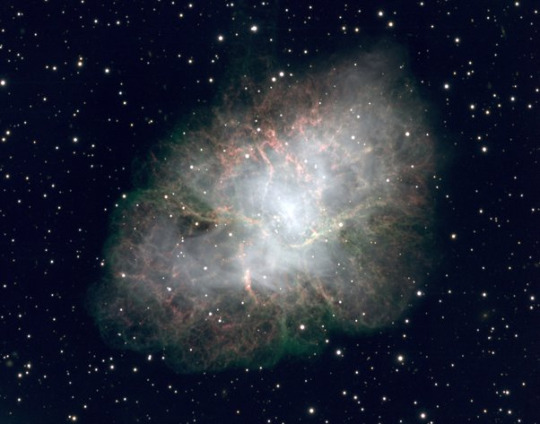
Each cone of your eye reads different parts of the light spectrum. The electromagnetic spectrum refers to the entire range and scope of frequencies of electromagnetic radiation and their respective, associated photon wavelengths. Your eyes get excited by the wavelengths and can see the wavelengths for visible light. If you could see infrared, you would see red. If you saw ultraviolet wavelengths you would see violet wavelengths.
The Visible light (and near-infrared light) is typically absorbed and emitted by electrons in molecules and atoms that move from one energy level to another. This action allows the chemical mechanisms that underlie human vision and plant photosynthesis. The light that excites the human visual system is a very small portion of the electromagnetic spectrum.

A rainbow shows the optical (visible) part of the electromagnetic spectrum; infrared (if it could be seen) would be located just beyond the red side of the rainbow with ultraviolet appearing just beyond the violet end.
Every object you see reflects light into your eye. That reflected light reaches our small, medium, and large cone cells located in the eye. Each cell reads a wavelength. The cones send a message to your brain telling it how much long, medium, and short wavelength light bounces off an object. Putting all that into a number code we refer to as color. Although light does not have a color, our brain generates a code when the spectrum of light enters the eye.

During the 1990s NASA launched one of the most complex space telescopes into Earth’s Low Orbit. Low Orbit is the altitude between the Earth’s surface and 2,000 kilometers (1,200 mi). Because it is outside our atmosphere, the telescope can view astronomical objects across a broad swath of the electromagnetic spectrum, from ultraviolet light, to visible, to near-infrared wavelengths. The telescope can also see faint objects near bright objects.
The telescope can resolve astronomical objects with an angular size of 0.05 arc seconds, which is like seeing a pair of fireflies in Tokyo from your home in Maryland. This razor-sharp vision is 10 to 20 times better than typical resolution with large ground-based telescopes.

It has revealed a whole new level of detail and complexity in a variety of celestial phenomena, from nearby stars to galaxies near the limits of the observable universe
When we look at a picture of a Nebula taken with the Hubble telescope we see terrific colors emitting from it. But is that how it really appears in space? No, for the sake of science, scientists color the pictures.
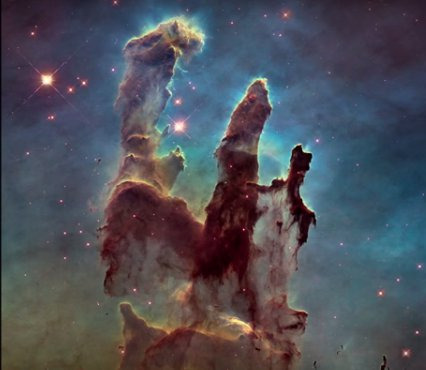
This famous picture of the Eagle Nebula, named Pillars of Creation, shows fantastic colors surrounding the nebula. Researchers will often add artificial colors to focus on an element or feature they are trying to study. Assigning colors to different wavelengths allows them to learn more about each object. Infrared, microwaves, and radio waves give off deep reds. Ultraviolet, X-Rays, and Gamma-rays give of deep violet colors. While the Hubble telescope can detect wavelengths our eyes cannot see, scientists also color them to keep us interested in space.
Originally published on https://osr.org
COMING UP!!
(Saturday, July 23rd, 2022)
“WHY IS SPACE BLACK??”
#astrophotography#astrophysics#Astronomy#atmosphere#spacecraft#outer space#space#Sunspot#alternate universe#white universe#Parallel Universe#universe#Dark Matter#gamma rays#strange matter#antimatter#Mars#astronomy#parallel universe#astronomylover
72 notes
·
View notes
Text

~ Candid oracle of never-seen colors ~
Name: Kadelio Nossane Age: 20 Birthday: 15th of July Gender: Male (He/Him) Species: Half-beast Nationality: French Abilities: Compressing energy for various purposes; enhanced agility and sight.
-
“A fine and polite young man with mettlesome beliefs and optimism” is what comes to most people’s minds when talking about Kadelio. Which isn’t to say this is an incorrect view of him — it sums up his character very well. The problem arises when those values are taken too far.
Having been sheltered by his parents his entire life, Kadelio’s never-ending optimism is rooted in ignorance. He used to believe whole-heartedly that a peace between humans and beasts was possible — after all, his mother being a beast and his father being a human was proof of it. It’s only after witnessing one of the many massacres beasts induce that he started questioning those beliefs. However, this change in worldview did not go unpunished; when he exposed the problem and his thoughts to his parents, believing he could make a difference due to their status as politicians, he was thrown to the streets, where he learned the harsh way half-beasts are treated when they don’t have a high social status.
That is how he became part of Ethuline, as a hunter protecting humans against beasts. His role is more so that of support compared to Nora and Valti. He fights from afar thanks to his rifles, and can be of huge help to escape beasts in the most dire situations. Deep down, he still believes beasts can be reasoned with, a belief that isn’t shared by many in the camp. Nonetheless, he cherishes the camp, as this is the first time he gets to meet other half-beasts, and wants to protect his kind at all costs.
-
Being a half-beast, Kadelio is of course more suited for combat than a regular human. However, unlike Nora, he doesn’t have much experience or skills, as he joined the team years after Nora started this beast-hunting business.
His enhanced agility is incredibly helpful. Able to jump to great heights and match the top running speed of a hare, he can make up for his lack of experience and easily escape beasts when needed.
The antennae he possesses on his wrists, waist, chest, and head are unfortunately not retractable. In the camp and the subways, that isn’t an issue, as he doesn’t need to hide them and only needs to tie the head antennae so they don’t fall into his eyes. The problem arises when he needs to go on the surface. His usual solution is a very covering attire and a beanie.
His most powerful ability is the ability to condense energy, which makes him able to create small explosions instantly. However, because that ability is highly hazardous, using it by itself can backfire. To counter this, Valti created twin rifles, allowing Kadelio to regulate the energy bullets’ size, give them a precise timing and trajectory to follow, and not injure himself when using his powers. The rifles themselves do not have a proper firearm mechanism. To the unknowing person, they’re merely props.
Kadelio’s vision is far superior to that of any other living being’s. He can see the light at any frequency on the electromagnetic spectrum, from radio waves to gamma rays. That of course includes microwaves, infrared, visible light, ultraviolet, and X-rays. He can see them as colors that we as humans cannot comprehend, to his dismay. Because seeing all colors at once would simply break his mind, he can only see a fraction of it at a time. His regular window of vision is still centered around visible light, slightly overtaking UVs and IRs, but he can move it to other bigger or smaller frequencies (and thus, temporarily removing his ability to see visible light). To him, it feels like focusing and unfocusing his eyes.
Coupled to this ability, Kadelio also has projective synesthesia. More specifically, gustatory-color and olfactory-color synesthesia. Which means triggering one sense (i.e. eating food, smelling fragrances) can trigger another (i.e. seeing colors). Because he can see lights of other frequencies, he also associates these “colors” to tastes and smells.
-
Design details:


-
Kadelio, my rainbow boy. I am incredibly proud of how this intro illustration turned out! Like Valti he's incredibly fun to put in situations. The combinaison synesthesia/enhanced sight was something that I thought of quite late, but I'm glad I did, because there's a lot of potential to it and I really want to exploit all of it.
2 notes
·
View notes
Text
Physics...Done right

The name of Gojou’s Limitless’ form “Reversal: Red“ has actual, solid foundation, connected to the Doppler Shift.
Specifically, the “Red-shift”.
The easy ways of explaining it are two: a star or an ambulance’s siren.
Yeah, I know, pretty different objects, but it’s gonna make sense, I promise.
First of all, we have to talk about the involvment of light (and sound) and its wavelenght
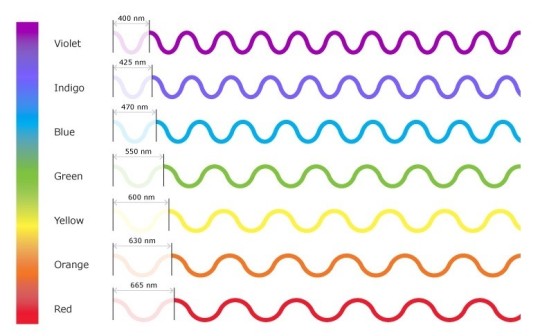
Star
If a star moves away from us, we’ll see its ‘color’ (light) shift. This is because the light frequency lowers to a wider wavelenght, so towards red, and less energy (light) is able to reach us, distance-wise and void-wise; as much as empty space might seem, there’s still a shtickton of stuff we can’t see nor detect into what we consider ‘void’.
Could it be a subtle input on the nature of Unlimited Void? I wouldn’t be surprised.
Ambulance’s siren
When you hear the ambulance approacing you, the siren has a higher pitch, but strangely enough, when it surpasses you and moves away from you, you quickly realize the sound becomes deeper the more distant the ambulance goes. That is exactly the same thing that happens, but with sound, which is another physical unit running on wavelenght. The wavelenght dilates while the ambulance is distancing us, thus producing a progressively lower tone.
Long story short, this is why Reversal: Red might be a name given to a techinque that pushes stuff away from you. It’s not connected to the objects/people themselves more than the concept of their action, their straying, resulting from Gojou’s space and cursed energy manipulation.
The rest of the rant lays down below, don’t continue if you don’t wanna be spoiled.
If you do, welp, not my fault.
As a star move towards us, its light will shift on the spectrum closer to the blue, because its frequency will get higher and the wavelenght will compress. Thus, the energy level is increasing the nearer it gets to us.
I can hear y’all thinking “Oh, THAT’s why the other one is called Forward: Blue.”
Yep, precisely :D
Same as before - and on the contrary at the same time - the form might be named after the “Blue-shift”, the other effect of the Doppler shift.
With the ambulance: as it approaces, you can hear the pitch getting higher and higher; the sound’s frequency hightens, getting to its “blue” peak when it is front of you.
Following the concept of something getting NEARER to you, “Forward: Blue” works pulling in, towards Gojou.
Now, we reached Hollow: Purple. This is were the speculations and the fun begin.
You might ask me: but, Moody, you used an image where blue is not the end of the line, there’s violet (purple) right there. So why not call it ‘Forward: Purple’?
Hollow: Purple then doesn’t seems to make sense. Also, purple is still the mix of blue and red, right?
Well....yes (Hollow: Purple seems to not make sense using the Doppler Shift), yes (purple is still the result of mixing red and blue) and no (it’s shouldn’t be called Forward: Purple).
I think Hollow: Purple mixes the color wheel scheme theory, the ‘spectral’ violet light, and how we are able to perceive violet.
First, let’s talk about how the human eye “sees” this color, ‘cause it’s a trick :P
I’m explaining:
Our eyes have nice little cells to differentiate colors, named photoreceptors: cones and rods.
Usually we have 3 types of cones, each of those reacting to 3 main wavelenghts: blue (high frequency) green (medium frequency) and red (low frequency). Rods are all the same and they’re sensitive to the amount of light (or brightness) in the environment. They’re also the ones who permits us to see during nightime (in a grayscale, ‘cause the cones turn off during the night).
Our eyes’ lenses shields us from the high-energy radiations coming from Sun and space, which are detrimental and dangerous (but some of them are very useful) on a variety of level (UVA [black light], UVB, UVC [germicide], X-rays, ϒ-rays...the nasty stuff, :D). Thus, violet and/or ultraviolet cones don’t have a reason to exsist, since those wavelenghts are not supposed to reach the retina.
Following this idea, we cannot see the wavelenght of violet.
But we see violet.
As the frequencies of the colors stimulates one or more cones and a certain amount of rods, we are able to distinguish more tints, like cyan, magenta, yellow (CMYK...yes, those very one), brown, pink, ochre, gray and all the other shades in between...and yes, purple as well, as a mix of blue and red cones’ activation. Now this makes sense, right?
Here’s a nice and easy list of how colors come up.
We can see purple, but at the same time, we are not.
We can see it as a ‘cone-mix’ color, but not as a ‘spectral’ color.
There’s an anatomical condition called aphakia (greek - “without lens”) in which a person doesn’t have (naturally or because of surgery/incident) one or both lenses, so the radiation is able to enter the eye and they can “see” the ultraviolet light. Still, it’s not the bright purple we might imagine; some of them define it as a blueish-purpleish white (if someone who’s reading this is aphakic, please don’t be afraid and share your version with us!).
Complicated? Yeah, I feel you.
In my opinion, “Hollow: Purple” extrapolates both this concepts: it is the combination of Red and Blue as cones’ stimulation (color wheel) = Gojou’s techinques of pushing and pulling, which escalates from a ideological nonesense into a consequent annihilation, and something that seems real, feels real, really isn’t, but still happens.
Like "Violet Light”, indeed :)
Same as UV spectrum energy, Hollow: Purple destruction capacity is bordeline-armageddon.
Funny last detail: red is supposed to carry the less amount of energy, while blue has the highest, but in the story it’s the opposite. Reversal: Red is said to be twice the strenght of Forward: Blue, because Gojou is actually manipulating Blue (the original form) into Red, converting negative energy into positive, thus increasing the devastation scale.
#best boi gojou#gojou satoru#satoru gojou#gojo satoru#jjk#jujutsu kaisen#sorcery fight#jjk theories#jujutsu kaisen theories#jjk theory#jujutsu kaisen theory#gojou theories#best sensei gojou#he's gonna be alright guys#cursed techniques#limitless#reversal red#forward blue
234 notes
·
View notes
Text
Swift: Our Sleuth for the Universe’s Gamma-ray Bursts
The universe is full of mysteries, and we continue to search for answers. How can we study matter and energy that we can’t see directly? What’s it like inside the crushed core of a massive dead star? And how do some of the most powerful explosions in the universe evolve and interact with their surrounding environment?
Luckily for us, NASA’s Neil Gehrels Swift Observatory is watching the skies and helping astronomers answer that last question and more! As we celebrate its 15-year anniversary, let’s get you up to speed about Swift.

What are gamma-ray bursts and why are they interesting?
Gamma-ray bursts are the most powerful explosions in the universe. When they occur, they are about a million trillion times as bright as the Sun. But these bursts don’t last long — from a few milliseconds (we call those short duration bursts) to a few minutes (long duration). In the 1960s, spacecraft were watching for gamma rays from Earth — a sign of nuclear testing. What scientists discovered, however, were bursts of gamma rays coming from space!
Gamma-ray bursts eventually became one of the biggest mysteries in science. Scientists wanted to know: What events sparked these fleeting but powerful occurrences?
So how do gamma-ray bursts and Swift connect?
When it roared into space on a rocket, Swift’s main goals included understanding the origin of gamma-ray bursts, discovering if there were additional classes of bursts (besides the short and long ones), and figuring out what these events could tell us about the early universe.

With Swift as our eyes on the sky, we now know that gamma-ray bursts can be some of the farthest objects we’ve ever detected and lie in faraway galaxies. In fact, the closest known gamma-ray burst occurred more than 100 million light-years from us. We also know that these explosions are associated with some of the most dramatic events in our universe, like the collapse of a massive star or the merger of two neutron stars — the dense cores of collapsed stars.

Swift is still a powerful multiwavelength observatory and continues to help us solve mysteries about the universe. In 2018 it located a burst of light that was at least 10 times brighter than a typical supernova. Last year Swift, along with NASA’s Fermi Gamma-ray Space Telescope, announced the discovery of a pair of distant explosions which produced the highest-energy light yet seen from gamma-ray bursts.
Swift can even study much, much closer objects like comets and asteroids!

Why is Swift unique?
How do we study events that happen so fast? Swift is first on the scene because of its ability to automatically and quickly turn to investigate sudden and fascinating events in the cosmos. These qualities are particularly helpful in pinpointing and studying short-lived events.

The Burst Alert Telescope, which is one of Swift’s three instruments, leads the hunt for these explosions. It can see one-sixth of the entire sky at one time. Within 20 to 75 seconds of detecting a gamma-ray burst, Swift automatically rotates so that its X-ray and ultraviolet telescopes can view the burst.

Because of the “swiftness” of the satellite, it can look at a lot in 24 hours — between 50 and 100 targets each day! Swift has new “targets-of-opportunity” to look at every day and can also look at objects for follow up observations. By doing so, it can see how events in our cosmos change over time.
How did Swift get its name?
You may have noticed that lots of spacecraft have long names that we shorten to acronyms. However, this isn’t the case for Swift. It’s named after the bird of the same name, and because of the satellite’s ability to move quickly and re-point its science instruments.
When it launched, Swift was called NASA’s Swift Observatory. But in January 2018, Swift was renamed the Neil Gehrels Swift Observatory in memory of the mission’s original principal investigator, Neil Gehrels.

Follow along with Swift to see a typical day in the life of the satellite:
youtube
562 notes
·
View notes
Text
Nikola Tesla and the True Explanation of the Photoelectric Effect
by J. J. J.

The photoelectric effect is a phenomenon which occurs when electromagnetic radiation, such as ultraviolet light, is exposed to certain metallic objects causing the metals to emit electrons from their surface.
In 1905, Albert Einstein gained world fame for supposedly being the first scientist to successfully describe this effect. His theory was that light had little packets (quanta) of energy, or photons, and when exposed to metallic objects at certain frequencies the electrons in these metallic objects would absorb this energy and be broken off from their source. Hence, photoelectrons.
This theory led to the wave-particle duality of light since light seemed to act as both a wave and a particle. In 1921, Einstein was awarded the Nobel Prize in Physics for his theoretical and mathematical explanations of this effect. A theory that even today is still accepted as a fact. But According to experiments, research and data collected by Nikola Tesla, Einstein and many other scientists overlooked some key factors in their interpretations of the effect.
The history of the photoelectric effect goes back to 1887, when Heinrich Hertz first observed electromagnetic waves in experiments, first predicted by James Clerk Maxwell over twenty years before. After this great discovery, Phillip Lenard and many other scientists, including Nikola Tesla, followed Hertz’ work with their own investigations into the matter.
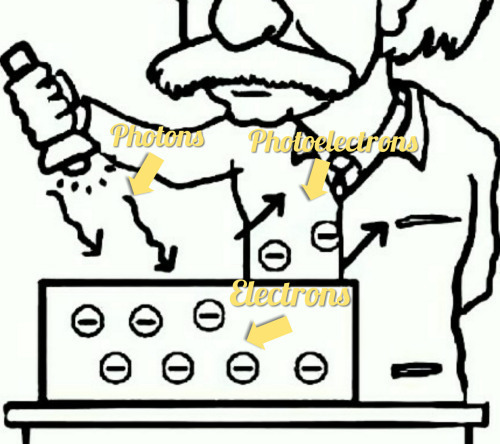
In 1889, after freeing himself from work in Pittsburgh, Tesla returned to New York to begin work on high-frequency apparatuses, the wireless transmission of energy, and to develop theories on the relationship between light and electromagnetic radiation. It was right around this time in Tesla’s life when he was starting to gain world fame. His alternating current system was finally getting recognition, and he was being asked to give lectures and demonstrations all over the world. On top of this, he was making new discoveries one after another. One very important discovery he made was the discovery of X-rays in 1894, which he called “shadowgraphs.” These mysterious radiations were still very new to him at this time so he wouldn’t realize their importance until a year later when Wilhelm Roentgen made public the same discovery that would win him the first ever Nobel Prize in Physics in 1901. Unfortunately, Tesla’s laboratory would burn down eight months before Roentgen announced his discovery, and the inventor would lose all his laboratory data, notes, plans, photographs, tools, and inventions. So it must be noted that Nikola Tesla was indeed the first scientist to discover X-rays.
After recovering from the fire that destroyed his laboratory March of 1895, a tragedy that set him back a great deal in work, Nikola Tesla was finally able to resume his work in 1896. Throughout the next few years Tesla would conduct and publish in periodicals his many experiments with radiant energy, such as radio waves and X-rays. This would put him on record for being the first scientist to discovery radioactivity, electrons, and the first to propose that light and other electromagnetic radiations had both particle-like and wave-like properties—predating Henri Becquerel’s radioactivity discovery by a few months, J.J. Thompson’s discovery of the electron by a couple years (both Becquerel and Thomson won Nobel Prizes), and Einstein and other quantum physicist’s light theory by nearly a decade. But Tesla’s views on these effects were much different than other’s.
In experiments with his newly developed high-vacuum tubes and his high-frequency disruptive coil (Tesla Coil), Tesla shot cathode, and other rays at different metals noting the differences in reflection the streams made upon the metals. His experiments indicated six conclusions:
1. His highly exhausted bulbs emit material streams which, impinging on the metallic surfaces experimented with, are reflected.
2. These streams are formed of matter in some primary or elementary condition (what we now consider photons/or electrons).
3. These material streams are probably the same agent which is the cause of the electro-motive tension between metals in close proximity, or actual contact, and they may possibly, to some extent, determine the energy of combination of the metals with oxygen.
4. Every metal or conductor is more or less a source of such streams.
5. These streams must be produced by some radiations which exist in the medium.
6. These streams resembling the cathodic must be emitted by the sun (cosmic radiations) and probably also other sources of radiant energy, such as an arc light or Bunsen burner.
He considered all conclusions incontrovertible, and with these results, Tesla believed it probable that there is a continuous supply of such radiations in the medium in some form which must come from the sun. Later experiments with the above conclusion would lead Tesla to his discovery of cosmic rays, which he also discovered come from not only our sun, but from every other star outside our solar system. This discovery would be fifteen years before Victor Hess, who also won a Nobel Prize for this discovery, who even today we still recognize as the discoverer of cosmic rays.
Tesla also suggested that the primary particles composing the cosmic rays are broken into smaller particles by impact against certain metals, and are thereby enabled to pass into the air. His analogy was that of shooting a bullet at a wall. When the bullet strikes the wall it is crushed and spatters in all directions radial to where it hit the wall. So according to Tesla, the energy from the flying pieces can only come from that of the bullets, and the results will differ based on the density of the wall, and or the velocity of the bullets. For instance, X-rays are incomparably smaller than cathode rays and have a higher velocity, which is why we are unable to detect X-rays and assume them to be massless photons, while cathode rays are slower so we have been able to label them electrons. This is how Tesla’s radioactivity theory differs from today’s. He realized it was the cosmic rays, and other sources of radiation that cause the radioactivity on earth. We believe the metals, or the elements themselves are producing the radioactivity from within and emitting electrons, like Einstein’s photoelectric theory suggests, but Tesla’s theory obviously suggests otherwise.

Now to make the above experiments more precise and prove his cosmic radiation theory further, Tesla developed a better method. He used two conductors and connected them to terminals of a condenser which had a considerable electrostatic captivity. One conductor was a metal plate exposed to the Sun, and other radiations, and the other being grounded since it is a supply of negative electricity. Now Tesla could derive from a great mass of air, ionized by the radiation disturbance, a current, and store its energy in the condenser. He could also discharge the current through an indicating device. This method did away with the limitations and incertitude of the electroscope, and gave Tesla much better results. He filed a patent based off these results titled, “Apparatus of the Utilization of Radiant Energy,” published in 1901. This would obviously be a precursor to solar panels, but still more advanced than today’s panels, because it ran off cosmic radiation and not just our sun’s light.
So in order to get results like Tesla obtained, one would need to reproduce Tesla’s experiments and patents. You can search anywhere online and see demonstrations of the photoelectric effect, but all are using the weakest instruments to demonstrate the effect–like a basic ultraviolet light and an electroscope. The fact that today’s physical science relies on such demonstrations to prove its theories seems to show that science may not be as advanced as we tend to believe.
Tesla’s work would obviously get ignored by main stream science, but it seems that today’s technology, which seemingly works off Albert Einstein’s theories, are in reality, working off Tesla’s.
“There can be no great harm in a student taking an erroneous view, but when great minds err, the world must dearly pay for their mistakes.”–Nikola Tesla
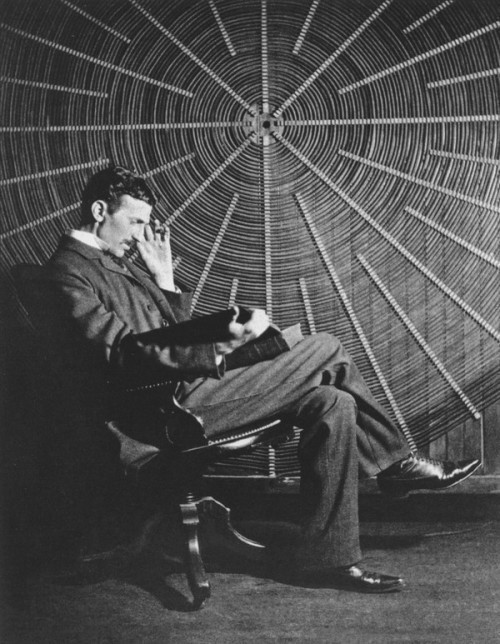
#nikola tesla#physics#quantum physics#history#photoelectric effect#albert einstein#photons#electrons#photoelectrons#quotes#cosmic rays#ahead of his time#ahead of our time
130 notes
·
View notes
Text
Halloween 2021 - Day 5 - The Invisible Ray (1936)

Doesn’t that just sound like a bad magician? “Ladies and gentlemen, introducing...The Invisible Ray!”

Ah, this takes me back. Back in year 0 of this horror marathon business, before this blog was a thing, it was kinda heavily skewed towards the ‘classic’ period; Dracula, Frankenstein, The Mummy..all that Universal 1930’s type stuff. Amongst that first run were a pair of films starring both KARLOFF and Bela Lugosi; The Black Cat and The Raven. I remember them both being quite good, both having this sort of rivalry between their two characters. The Black Cat moreso with a young couple caught in the middle of a heated feud between KARLOFF and Lugosi’s characters. Whereas The Raven has KARLOFF as more of a de-facto good guy as he plays a reluctant henchman to Lugosi’s character. Not that that level of power translated off screen, with Lugosi’s star beginning to fade but I remember reading something about KARLOFF insisting on some parity in pay between the two in one of their movies when the studio tried to lowball Lugosi so good on you, KARLOFF.
Neither have much to do with the Edgar Allan Poe stories they take their names from, outside of Lugosi’s character in The Raven having an obsession with Poe and adapting various means of torture from Poe stories. There have been plenty of Poe adaptations throughout the years but the other big uptick in them was in the 1960’s with a series of films directed by Roger Corman, often starring Vincent Price but with other big names sprinkled in like KARLOFF, Peter Lorre and Lon Chaney Jr. Plus a relatively early Jack Nicholson appearance in The Raven, which was shot at the same time as The Terror. That bloody bird!
So, yeah, it’s good to see one of these KARLOFF/Lugosi films again. Apparently there are eight films that featured both of them so I’ll be halfway there now on them. This also has Carl Laemmle Jr’s name attached, albeit in a minor way as he’s listed as ‘presenting’ the movie. I’m not sure if that ever means anything. It’s like when Tarantino ‘presents’ something, did he have any actual input on the film or was he just shining a light on something he personally liked because he has so much power and influence?

The movie’s foreword is an early indicator of the more science-fiction leaning nature of the movie which catches you off guard a little with the people involved and the timeframe we’re working in. Feels like the 50’s was more when the whole sci-fi thing took off. Also, since when was science a verb?
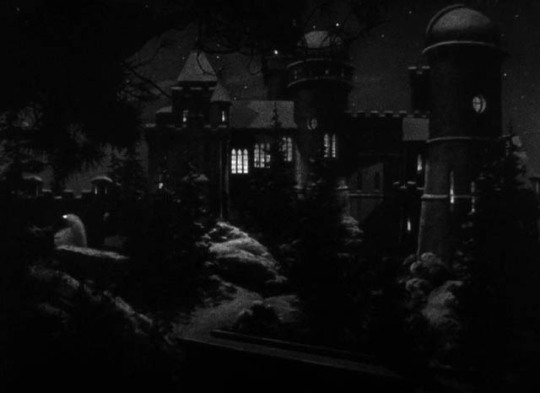
Certainly has the feel of that classic ‘old, dark house’ horror thing early on as we start with the Rukh household awaiting the arrival of some of Dr Janos Rukh’s (KARLOFF) peers who are to bear witness to his new discovery.

KARLOFF has clearly been eating his crusts to get curls like that, normally he’s a slicked back kind of guy. And it’s kinda weird seeing both of them with facial hair. Oddly though this is one of the rare times that Lugosi plays a good guy, this is a clear violation of the parallel universe protocol:
Normal universe – clean shaven – good guy Parallel universe – goatee – evil
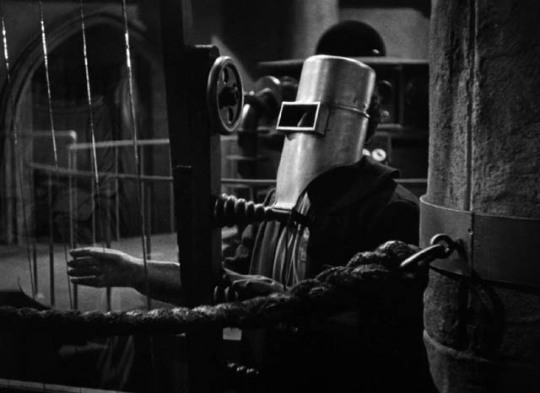
This early version of Dr. Doom is a bit naff. Are you making a great scientific discovery here or doing a spot of welding?
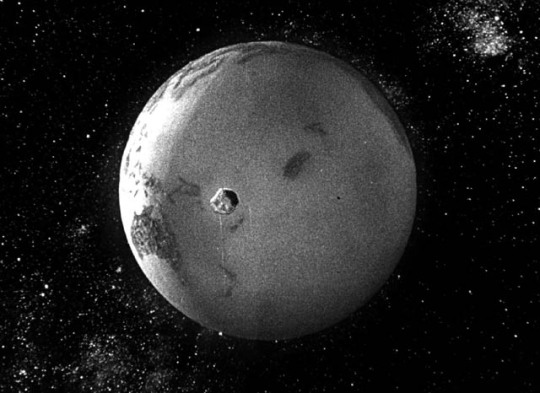
Apparently Dr Rukh’s invention is a telescope that is able to see into the deepest reaches of space, but can also pick up on vibrations left by the events that have taken place and he can then project that as a moving image that shows an asteroid crashing to Earth millions of years ago that can help him pinpoint the crash site and allow him to discover new elements inside the asteroid...wait, what?! Is this like that time on CSI when they solved a murder by getting sound out of something someone made in pottery class because the grooves could be played like a vinyl?

We then pivot sharply into the great plains of Africa where our team have set off in search of what will become known as ‘Radium X’. Oh yes, I think that’s on the periodic table next to Hardtoobtainium. And I’m specifically trying to avoid animal cruelty by not watching Cannibal Holocaust, don’t come around here with your dead leopards and talk of how many rhinos you’ve shot. I must say I’m a little wary of this sudden introduction of all these natives carrying spears and wearing bone necklaces, I just don’t feel like I can trust a movie made in the 1930’s to be sensitive on it’s portrayal of other cultures.

Thought it does present us with the best actor in this picture, look at those bug eyes! He’s like Africa’s answer to Marty Feldman.

And that’s just his reaction to a piece of scanning equipment going off, him and his mates are definitely going to be worried when this white devil makes a demonstration of his new found Radium X and it’s ability to melt pure stone. Looks like a portajohn backing up...

He then promptly turns his cosmic ray gun on all the locals when they tell him they want to go home. Sure, you can leave, you’re not going to get very far though. Dude, there’s like 12 of you and he’s given some of you rifles. Just jump him when he’s asleep.

Dr. Rukh finds that evening that he’s suddenly turned an interesting shade of neon yellow and can be seen by anyone in a three mile radius so either this Radium X is highly poisonous or Rukh has been running in opposition to Vladimir Putin. This poisoning leaves him so irradiated that merely touching another living thing is enough to kill it. Dr. Benet (Lugosi) is able to make a serum for him but can never truly cure him, he must regularly take this serum or otherwise he will revert to this killing machine type state.
But, in his eagerness to not spread this poison to his wife, and his general upholding of the man code to never air ones medical problems, he generally acts a bit surly and tells her to piss off which see views as him not loving her anymore so he promptly shacks up with the young explorer type who came with them to Africa. Worse yet, Benet and crew have taken a sample of Radium X to show at a scientific conference in Paris. Between losing his missus and thinking that other people are taking all the credit for his work, Rukh is just slightly annoyed.
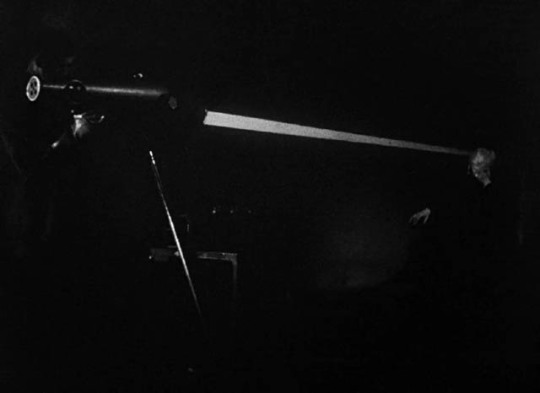
It’s not all bad though, he is able to use this new element to cure his mother’s blindness. I like how his first reaction upon learning that Radium X has irrecoverably changed his life, leaving him one missed injection away from imminent death, is to shoot it directly into his mother’s face.
“Patients won’t like being shot in the face.” “They’ll like what I tell them to like.”

Whilst sulking outside of the church that his ex is getting re-married in, he spots a series of statues of saintly figures and imagines them representing each of the 6 people on the African expedition, vowing to destroy each of them until only he is left. Marvelous invention this Radium X, it can melt statues and cure blindness. Do you have to put special filters on that ray gun of yours depending on the situation? That’s a malpractice suit waiting to happen if you mix those up.
Dr. Benet is a little suspicious when one of their party dies suddenly for no explainable reason so takes a few ultraviolet photos of the victims eyes in order to study. And wouldn’t you know what he finds?
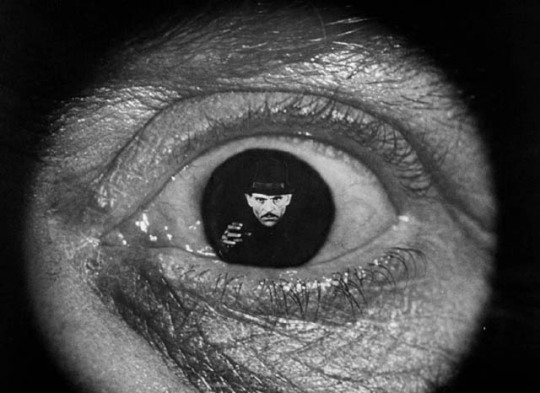
Bullshit! Nevermind the ultraviolet camera, this is more like the dues ex machine camera. I know this is science fiction and all but what is this, 1936 or 2036? Or maybe they’re just able to make the most detailed contact lenses known to man.
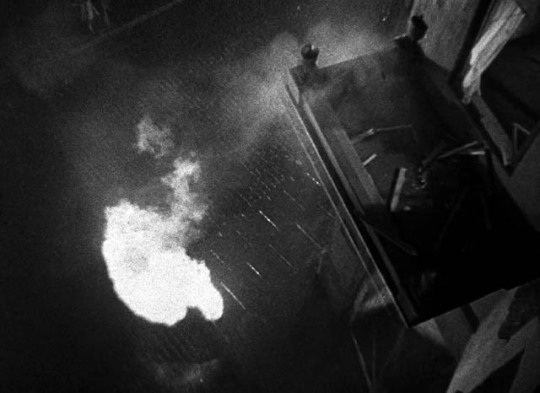
Eventually, when Rukh finds himself unable bring himself to kill his former love, he is confronted by his mother who smashes the serum and condemns him to death as, going unchecked, the Radium X within him will destroy his body. Sensing the end coming, Dr. Rukh dives out of the nearest window and promptly erupts bursts into flames, now left as little but a pile of ash on a damp Paris street. It’s a shame really, dozens of people spontaneously combust every year, it’s just not widely reported.”
This one was okay, definitely a different vibe compared to other Universal stuff at the time with all the science fiction and Africa based stuff but it does still travel down that ‘descent into madness’ thing that they often fall back on and it’s always fun to see KARLOFF and Lugosi, especially when they’re together. But, if we’re strictly talking about the KARLOFF/Lugosi pairing, I’m definitely leaning towards one of their other outings like Black Cat, Raven or Son of Frankenstein. There’s just something not right about Lugosi playing some normal, if he’s not being unhinged then you’re not really getting what you came here for.
2 notes
·
View notes
Photo

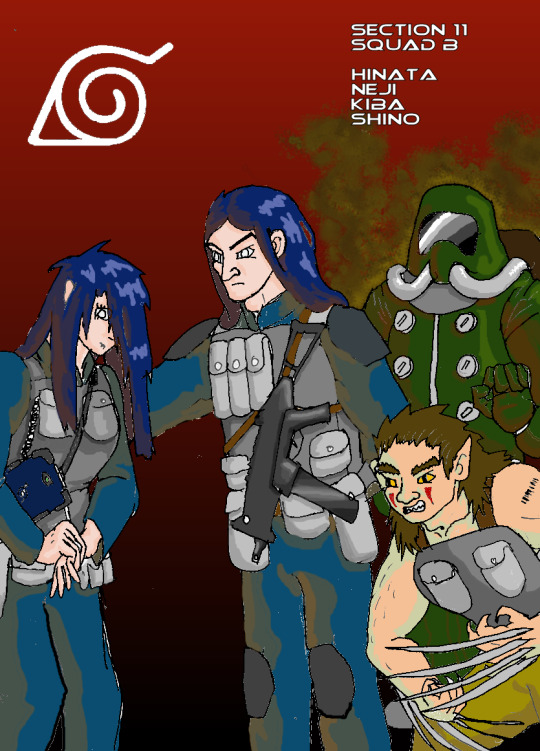

SQUAD A: Primary function--assault and destruction. Operative 07, codename ""Delilah" Previous attempts to recreate Hulk-like abilities have invariably met with disaster due to the accompanying berzerker rage. The Section 11 scientists took a different approach and instead tried to replicate the work of Dr. Samson, tying the particular super-strength of the Hulk to the length of the subject's hair. Trace genetic samples of the Red Hulk were used in experimentation on a test subject. Project deemed a partial success, though "Delilah" still has high levels of aggression and can be difficult to control, particularly if her hair length is not maintained within optimal parameters. Operative 01 has displayed a marked affinity for her, but so far experiments involving attempts at breeding have met with no success. [COMMANDER'S NOTE: "Breeding?" Are you serious with this? Damnit, those eggheads are messed up.] Operative 08, codename "Waif" "Waif" is unusual in not coming from the usual pool of test subjects, but is in fact the natural daughter of one of Section 11's lead scientists, Dr. Yamanaka. Her powers emerged at a young age uncontrollably during a traumatic car accident that killed one of her closest friends. Her powers were uncontrollable and destructive until the implant could be successfully installed. Though Dr. Yamanaka has attempted, since, to speak with his daughter, she does not seem to recognize him or anyone from her old family at all. "Waif" is one of the few operatives in Section 11 permitted to wear non-standard gear, as disruptions to her daily routine have been observed to have a negative impact on her stability. [COMMANDER'S NOTE: Guy lobotomized his own daughter. No wonder she won't talk to him.] Operative 09, codename "Samurai." "Samurai" is a clone created by Dr. Akimichi, spliced with DNA from the metahuman Blob. His armor is developed based on intense study of the metahuman Juggernaut and his armor. Though docile and responding well to direction, "Wamurai" has little initiative of his own. He also does not speak, and only communicates through "Waif." He has been observed to have a calming impact on her, hence why the two are paired together. "Samurai" also carries a series of steroids and stimulants for use in high-stress combat situations, and has received military training. [COMMANDER'S NOTE: Love this kid. Like a minature tank.] *Note: Given the volatile nature of the group, they require extensive coordination. Dr. Nara's "Deer" AI has proven useful in this task, supplemented by Shadow drones capable of observing and compiling data.** **Further Note: Dr. Nara's "Deer" AI has been flagged for review after numerous incidents displaying near-sentience, including several statements curiously similar to Dr. Nara's late son. Director Danzou has ordered an investigation into thJA)djs&(*Yhiue---------RECORD DELETED
SQUAD B--Primary Function: Infiltration and Recon Operative 03: "Gemini 1" Gemini 1 is not suited to intense combat situations unless supported by Gemini 2. Her primary skill set is stealth, infiltration, and cyberops. Similar to Gemini 2, she possesses hyper-optogrophy and can see in multiple layers of the spectrum, including infrared, ultraviolet, and x-ray. Energy blasts from the palms are able to target internal organs. Tests have also confirmed a psychic link between her and Gemini 2, wherein information and even physical pain can be conveyed between one and the other. Gemini 1 has also been observed to have a notable attraction to Operative 01, which might possibly be useful. [COMMANDER'S NOTE: Who authorized that test, and how was "physical pain" determined?] Operative 04: "Gemini 2" Gemini 2 is the twin of Gemini 1 and possesses all her abilities. He has a much higher combat aptitude, and has been noted in field operations to have a particular protective instinct involving Gemini 1. It has also been noted that Gemini 2's combat effectiveness dips noticeably when confronted with anti-citizens Kusanagi and Green Beast. Confrontations should be avoided. [COMMANDER'S NOTE: Who did we get these twins from, I wonder. Probably from one of the "clinics."] Operative 05: "Weapon K" Weapon K is the most successful emulation of the Weapon X project thus far. Though it is still difficult to maintain complete control, and the adamantium binding process was not entirely successful, still he retains the all-important healing factor acquired from Weapon X, as well as the heightened senses. Weapon K handles the majority of combat situations that Squad B encounters, though he is indiscreet and tends to leave a mess behind. [COMMANDER'S NOTE: Just something not right about this boy.] Operative 06: "Shino Entity" It has yet to be determined whether Shino Entity is, in fact, a budding psychic who was consumed by insects and gained control of them, or merely a strange collective of psychic insects under a shared delusion of once having been human. Investigation is ongoing, though attempts to isolate and inspect individual insects of the hive mind have been counter-productive, as Shino Entity has invariably become aware of the isolation and dissection of members of his hive mind. Accordingly, invasive experiments have for the moment been suspended to ensure his ongoing collaboration. His skill set is incredibly valuable and unique, however, enabling mass recon on a almost simultaneous response, and while not suited to combat, is essentially indestructible. Shino Entity requires little care save maintenance of the containment suit and a daily piece of rotten meat. This seems sufficient to have earned his cooperation, along with a curious affinity for the other members of Squad B--though it still has not been determined how he manages to speak. [COMMANDER'S NOTE: I don't really care where he came from. As long as he keeps up his work, he can call himself Shino or Lord Nelson for all I care.] LEADERSHIP TEAM Commader Kakashi: Field Commander. Last living member of the original Section 11 team, Commander Kakshi has been declared not fit for combat due to the injury suffered to his eye during the Apocalypse Incident. He now serves Section 11 in a supervisory tactical role, planning out missions to accomplish goals as set by the rest of the leadership. Though not strictly required, Commander Kakashi makes a habit of deploying with the Section 11 Operatives whenever possible, a practice which Section Chief Danzou has cited him for numerous times. [COMMANDER'S NOTE: Let the old man complain, I'm not sending kids out there without backup.] Dr. Tsunade: Head of Mutagenic Studies. Dr. Tsunade left a promising career at Tokyo University to lead the medical and study wing of Section 11. She is in charge of monitoring the operative's physical state and the nature of their mutations, as well as any new mutations that arise. Dr. Tsunade's connection to the program is more than professional, as her grandfather was closely involved in its creation, a fact which may have weighed into her decision to join. Dr. Tsunade also considers herself in charge of the operative's well-being, a matter which has also led her to clash with Section Chief Danzou. [COMMANDER'S NOTE: The lady should be in charge from everything I've seen. Though what she did to the meeting table makes me wonder if her studies have been leading to more practical applications of mutagens, recently.] Dr. Inoichi: Section Chief Danzou's successful recruitment of the famous "Ino-Shika-Cho" team may be considered one of the great accomplishments of his administration. Dr. Inoichi joined the program out of desperation to find some solution to his daughter's newly awakened powers, and his two friends followed him. A neurology specialist, Dr. Inoichi has done groundbreaking work regarding metahuman psychics and extra-natural brain structure. He devised the device which currently helps his daughter to keep her powers in check, which is currently under development for possible use against enemy psychics. [COMMANDER'S NOTE: Why does the record note this as an accomplishment of Danzou's? Inoichi joined us because of his daughter's accident, Danzou had nothing to do with it.] Dr. Shikaku: Shikaku, a renowned specialist in artificial intelligence and computer learning simulations, joined the program alongside his friend. His algorithms run much of the training programs that the operatives use, as well as much of the predictive software crucial to Section 11's smooth operation. The death of his son left him emotionally distant and he has a noted reluctance to meet with any of the operatives outside of Inoichi's daughter. Much of his work since joining Section 11 has been on his prototype ASI "Shika" and its proxy drone. [COMMANDER'S NOTE: I swear, that thing almost seems sometimes like it's actually senti303@..%$)(~~~- ERROR DATA CORRUPTION... Dr. Chouza: The final member of the Ino-Shika-Cho team, Dr. Chouza's specialty runs more in the physical arena than either of his friends, primarily involving force multipliers such as the Hulk and Blob. His "Choji" clone program has potential to create an entire army once the formula has been perfected and the laboratory repaired. [COMMANDER'S NOTE: Chouza's heart isn't in this, and that laboratory will never be fixed if he has anything to say about it.] Section Chief Danzou: Despite his near-fatal injuries from the Apocalypse Incident, Section Chief Danzou has transformed Section 11 into an elite fighting force in the wake of his predecessor. The current roster and focus of the division is entirely due to his guidance. He has a noted tendency for keeping his plans to himself and frequently overrules his leadership staff. [COMMANDER'S NOTE: There is reason to believe that the old man has an even more dark-ops organization on the side, for missions he considers too sensitive even for Section 11.]
9 notes
·
View notes
Text
Worldbuilding Tangent 3
Part 1 / Part 2 And here’s the section that made me want to start writing about worldbuilding in the first place. Waterfall. And since there’s no way to avoid it, bits of Hotland too. (A reminder that these are my own observations and analysis of the Game’s text it is still only my interpretation of how this area MIGHT work if we attempt to apply real world systems Undertale’s world. It’s possible that I misunderstood or don’t know enough about the natural systems described and that things couldn’t work that way without some kind of magic, whether that of the Monsters or some natural source of it.) So let’s start off with my theories about Mt Ebbot itself. I think that at one point it was an active volcano. The area must have, in some primordial age of the world, been under high sea levels. There is no way for some of the larger caverns, such as the Snowdin Cavern, to have formed except through dissolution of Limestone over very long periods of time through water. Limestone is usually made from the accumulation of shell, coral, algal, fecal, and other organic debris at the bottom of bodies of water. As water levels receded over time, we were left with layers of limestone. Then at some point a magma chamber beneath the earth had an increase pressure and the magma was driven upwards. Interactions between magma and limestone are can cause extremely explosive eruptions, and its my guess that this caused the formation of what I’m calling the Grand Cavern which contains a huge portion of Waterfall as well as the City of New Home. This would have been a Stratovolcano, which is characterized by multiple explosions of both streams of magma and clouds of ash and thrown fragments. Usually such explosions are massive, and the high pressure of lava streams even underground might even lead to the formation of Lava Tubes. Volcanic activity and limestone would explain the presence of both the numerous crystals that decorate this part of the Underground as well as some the larger smoother areas of the visible caverns. Based on how the path seems to work, my guess is that streams of lava flooded upwards and the lava tubes formed became the main path of Waterfall. Then when the Volcano became dormant and the magma receded to lower areas, surface water began to flow back into the Underground, smoothing over and eroding at the volcanic surfaces of the caves and making waterfall much bigger as lava caves and tubes were opened into various Solutional caves and caverns or areas blasted open by the eruption as well as new layers of igneous rock which were easily eroded. Many speculate that there must be a body of water above this area of the Underground to produce that much constant water. I don’t entirely think so. While its likely that there is a nearby source for a large amount of water, there is so much water in this area that it can’t all stem from that. Part of it actually comes from the river we see in Snowdin. When you enter Waterfall, the river vanishes because you are in tunnels which are walled on one side, and drop off with the falls on the other into an unseen area (Will return to this). The river vanished behind these walls somehow, yet still manages to flow on steadily till it reaches Hotland and then the Core. My guess is that the river is one of several sources for water. Others include natural springs, probably some body of water on the surface such as mountain streams and various small lakes in the area. It is all of these that would allow water to collect in the Underground. Right above the area we travel through is probably a larger reservoir of water. Without such a thing, the water levels of this area would be affected seasonally and the caves would be dry at times, which is not hinted at anywhere. Also, Waterfall is one of the largest sections of the Underground and is significantly darker than other areas. Since the area is on the same level as most of the livable Underground, rather than deeper down, its likely that it sits under the main body of Mt Ebbot, while Snowdin Cavern, the area New Home sits under, as well as the Ruins are all much closer to the edge of the mountain and sometimes lie underneath the foothills and normal ground. This allows for the openings and shafts of light that are present in these other areas, but not so much in Waterfall. So our larger reservoir would collect water and its shores would ebb and flow as the water table was affected. It would also contain large amounts of trash if the visible area of Waterfall is any indication. Its possible that many denizens of this area live around the reservoir and river instead of in the lower tunnels, this would account for a good many monsters supposed to dwell here. We also have another piece of evidence that hints at the existence of multiple levels of the area by remembering that Undyne appears on the opposite side of the river with Papyrus at the beginning of the area. Behind them are some columns formed from limestone deposits as water drips down from above. Later she appears again attacking you through gigantic hand carved columns that line the edge of the dark water. Eventually though, if the reservoir got too low, such as during a drought, the water level in the lower areas would be affected too. Which Onionsan tells us is so with the comment that it gets shallower all the time and that many others have moved to a large Aquarium in New Home, though some are probably just eager to escape the Underground. We also appear to have rather large cliffs with standing water pools, probably a plunge pool or basin formed from the falling water. Other caves appear to hold huge bodies of relatively still waters allowing for the growth of “Water Sausages” or Typha, grasses of various kinds, and bioluminescent mushrooms and flowers. What kind of wetlands these areas area was a bit tricky to figure out. Since they are in a cave system and there are no trees in this area and limited vegetation and animals, then things like swamps and marshes can be eliminated. A bog was a possibility, until I remembered that unlike the Dark Waters areas which have near black water, one large area has its colors inverted making the land dark due to the light coming from the water. The probably cause of this is due to Bioluminescent Dinoflagellates. Dinoflaggellates are plankton that can be found in many bodies of water such as streams and lakes. But mostly they show up in the ocean. However bioluminescence is rare, and usually only occurs to aid in escape from predators, or to help find food in dark places. We have the dark down, but Bioluminescent Dinoflagellates require relatively stable conditions such as water that is not too cold but not terribly hot, and isn’t flowing too quickly. This along with the difference between the Dark Water area and this one means that this pool is probably somewhat warmer, maybe some very light geothermal activity, or simply the shape or makeup of the cave allowed for it to be just warm enough for Bioluminescence to develop over who knows how long. Since various forms of BIoluminescence are common in dark caves big enough for complex ecosystems, this wouldn’t be too strange. But the necessary warmer temperature rules out bog, swamp, fen, and bayou. Leaving us with a marsh. Since I have no real evidence of a sea or ocean (some people say that you can see one in the distance at the end of the game, but I looked and its too blurry to tell out that far. Could be ocean, could be more land, could be hazy horizon with the setting sun. Who knows.) its unlikely that its a saltwater marsh. This is doubled by all the fungi, freshwater plants, and such that live here, plus all of the underground gets its water from these connected rivers, lakes, and pools. So we’re left with freshwater marsh. A freshwater marsh is an area that is continuously or frequently flooded and primarily consist of sedges, grasses, and emergent plants. This checks all of our boxes for Waterfall while still allowing for enough stability in certain areas that the Dinoflagellates won’t be disturbed much. There are areas that are still very wet soil that grasses and mushrooms grow on plentifully, along with the clearly magical Echo Flowers. Though no mushroom exactly resembles those found in game, there are many many instances of bioluminescent fungi. The Echo Flowers sadly cannot be explained without magic of some kind, though there are a few very rare flowers that have bioluminescence, nothing but magic could be responsible for the echo mechanism. Also, the glowing of the crystals that make the stars is likely a natural phenomenon and the only mentions we get of them are that monsters have seen them and remember the stars. They are explicitly named as stones instead of the Arachnocampa luminosa gloworm species we are familiar with from the Waitomo Caves. So their glow must be due to some kind of Luminescence. There are several types of natural light minerals can produce, but unless the crystals have a source of light to give them energy, are glowing with intense heat, or are somehow being disturbed constantly and in ways that cause them to break chemical bonds... they’re probably magical. (Unless we want to say that the underground is flooded with Electromagnetic Radiation like Ultraviolet Light, Infrared Light, or X-Rays. I somehow doubt this is the case. Some of these would kill the monsters and any humans. Others would be impossible this far underground.) The light of the stars must be bright enough to allow the Typha to grow. Water Sausages are a resilient and adaptable species, but they must have some light because all studies showed that in total darkness they could no longer germinate. So while magic is probably involved, or this species has evolved greatly from being underground for a long time, this plant needs some light to survive. The Grand Cavern, where New Home is shown in the distance, also gives us a vague and shadowy impression of a lot of open space between you and the city proper. This is likely filled with fields for growing whatever food can be effectively produced in the Underground with limited light from the cavern ceiling, and the glowing crystals. Funnily, various parts of the Typha can be eaten either raw or after cooking and can also be used in medicines. Traditionally it has been used by certain indigenous cultures of British Columbia. This plant is probably a large part of Underground diets. We also see an abundance of fireflies around this area, who are nocturnal and wouldn’t have much problem down here. Finally I return to the countless falls that flow past you and down into the area below which we as players cannot see or reach. It is possible that the waters continue to flow down and erode or dissolve further caves and caverns below, maybe even form a massive lake or being absorbed into the stone and soil and vanishing (this depends on geological conditions down there). Now, while I think there is a great deal more room for monsters to spread out down there, it has a few problems with livability. Our biggest problem is light. Without sources of light such as the crystals or shafts of sunlight or glowing magma, it’s difficult to make a lot of things work. Because the Core is able to produce electricity due to geothermal activity, we know that the entire Underground is powered, so artificial light can be applied to crops and to every home, though clearly not every single section of the Underground. It’s possible that if Monsters found a safe way into the lower depths, they could easily use the extra room and find ways to power everything. But plant life would be scarce and limited to what artificial stuff they could grow or keep alive. It would be far more oppressive than living at higher points, even with an entire group of people you would begin to display serious psychological problems such as loss of spatial awareness or warped sense of time. This wouldn’t be a problem for most of the Underground because there are areas with large amounts of natural sunlight that leak through. But the deeper you go the more dangerous it becomes mentally. However Monster Biology is somewhat of a mystery to us and though they don’t display the strongest constitution when a human attacks with intent in their soul to do harm, perhaps they’d be more able to adapt for such living conditions since geological phenomena don’t usually possess intent to kill (At least...I hope they don’t.) Furthermore you could not only have dwellings at the bottom of the caves, but tunnels and small caves and stairs dug down into the cliffs beneath the waterfalls. The same can be said for the upper falls as well, allowing for far more territory in the area than can be seen by the player. But danger lurks in the future for the Waterfall area. It may not happen quickly, but as the water continues to flow, the stone that makes up the area will erode or be slowly dissolved. One day the roof of this part of the Underground will collapse. If the damage is extensive enough, the entirety of Waterfall could collapse into the deeper areas below we can only guess at and a massive sinkhole could open up on the surface. This process could take decades or happen very quickly. Hopefully there is enough of a rock barrier between Hotlands and any water displaced by said collapse, as such an influx of water and possible boulders of limestone to the Lava Lake could cause Mt. Ebbot to erupt.
#mt ebbot#volcanic activity#waterfall undertale#undertale#undertale theory#caves#caverns#lava tubes#subduction cave#limestone caverns#bioluminescence#bioluminescent dinoflagellates#freshwater marsh#onionsan#undyne#hotland#this is so long#but there's more coming
4 notes
·
View notes
Text


Indian spacecraft Aditya-L1 observes massive solar flare
When the sun hurled enormous amounts of radiation into space in an explosive eruption on February 22, 2024, the Indian space probe Aditya-L1, launched a few months earlier, was watching closely—and thus captured the first images of such a flare in the lowermost solar atmosphere.
Unlike Aditya, other solar observatories are "blind" at this distance from the sun, where the flares leave the solar surface. The new data will therefore help to improve our understanding of how flares form and how they propagate through the different layers of the solar atmosphere.
Among the solar probes in space, the Aidyta-L1 spacecraft is a newcomer. The solar observatory was only launched into space in September 2023 and took up its observation post at the near-Earth equilibrium point L1 between Earth and the sun shortly after.
After the initial commissioning of the seven telescopes and scientific instruments on board, the probe did not have to wait long for rewarding work: on February 22, 2024, there was a huge burst of radiation on the side of the sun facing the Earth. Researchers classify the flare as category X6.3 ranking it among the most energetic radiation bursts.
On Earth, eruptions of this kind can affect the operation of satellites, power grids, and radio communications. And a few months later, spectacular auroras, which could even be seen in southern Europe, were accompanied by similarly strong flares. Other space observatories, such as NASA's Solar Dynamics Observatory (SDO) and ESA's Solar Orbiter, as well as Earth-based telescopes, also turned their attention to the spectacular event.
Watching a flare erupt from the sun
The Solar Orbiter, in which the Max Planck Institute for Solar System Research is also involved, is much closer to the sun at a maximum of 42 million kilometers than Aditya-L1 at around 150 million kilometers. However, Aditya has another advantage: it sees where the flares originate. As a flare leaves the solar surface, it passes through various zones, starting from the surface of the sun at around 5,800°C and ending in the corona, which is more than 1,000 million degrees Celsius hot.
Because of the extreme temperature differences, the particle stream shines in different wavelengths, from the wavelength range visible to humans when it leaves the surface, through the ultraviolet range when it heats up to several tens to hundreds of thousands of degrees Celsius, to the X-ray range when it reaches the corona. Why the plasma gets hotter and hotter the further it moves away from the sun is probably due to the sun's constant energy eruptions, which heat up their surroundings.
Both satellites, the Solar Orbiter and Aditya, carry a range of instruments that observe the flare as it moves away from the sun and through the electromagnetic spectrum. Aditya-L1 has a special eye for long-wave UV light at 200 to 400 nanometers with the Solar Ultraviolet Imaging Telescope (Suit), and thus sees the region in which a flare erupts from the surface. This so-called lower chromosphere has not been accessible to researchers with this level of detail until now.
TOP IMAGE:The flare of February 22, 2024, recorded using the eight different filters of the SUIT instrument. Credit: SUIT/Aditya-L1
LOWER IMAGE: The Indian space probe Adiyta-L1. Credit: ISRO
2 notes
·
View notes
Text
TAFAKKUR: Part 404
SCIENTIFIC DISCOVERIES: A NOVEL PERSPECTIVE: Part 2
TEFLON
From non-stick frying pans to space suits to artificial heart valves, Teflon has found several areas of application. Its discovery resulted from an apparently ‘accidental’ observation by a young chemist, R. Plunket, working in Du Pont laboratories. On April 6, 1938, Plunket opened a tank of gaseous tetrafluoerothylene in the hope of preparing a non-toxic refrigerant from it, but no gas came out, to the surprise of Plunkett and his assistant. Plunkett could not understand this because the weight of the tank indicated that it should be full of the gaseous fluorocarbon.
Instead of discarding the tank and getting another in order to get on with his refrigerant research, Plunkett decided to satisfy his curiosity about the ‘empty tank’. Having determined that the valve was not faulty by running a wire through its opening, he sawed the tank open and looked inside. There he found a waxy white powder and, being a chemist, he realized what it must mean.
The molecules of the gaseous tetrafluoroethylene had combined with one another ‘polymerized’ to such an extent that they now formed a solid material. The waxy white powder did indeed have remarkable properties: it was more inert than sand - not affected by strong acids, bases or heat and no solvent could dissolve it - but, in contrast to sand, it was extremely slippery.
X (ROENTGEN) RAYS
Physicist W. Roentgen discovered the rays which were later to be named after him, in an unexpected and unplanned manner. Roentgen was repeating experiments by other physicists in which electricity at high voltage was discharged through air or other gases in a partially evacuated glass tube. We now know that cathode rays are actually streams of electrons being emitted from the cathode, and the impact of these electrons on the walls of the glass tubes produces the phosphorescence.
In 1892, it was demonstrated that cathode rays could penetrate thin metallic foils. Discharge tubes having thin aluminium windows allowed the cathode rays to pass out of the tube where they could be detected by the light they produced on a screen of phosphorescent material (such screens were also used to detect ultraviolet light), but they were found to travel only two or three centimetres in the air at ordinary pressure outside the evacuated tube.
Roentgen repeated some of these experiments to familiarize himself with the techniques. He then decided to see whether he could detect cathode rays issuing from an evacuated all-glass tube, that is, one with no thin aliminium window. Na one had observed cathode rays under these conditions. Roentgen thought the reason for the failure might be that strong phosphorescence of the cathode tube obscured the weak fluorescence of the detecting screen. To test this theory, he devised a black cardboard cover for the cathode tube. To determine the effectiveness of the shield, he then darkened the room and turned on the high voltage coil to energize the tube. Satisfied that his black shield did indeed cover the tube and allowed no phosphorescent light to escape, he was about to shut off the coil and turn on the room lights so that he could position the phosphorescent screen at varying short distances from the vacuum tube:
Just at that moment, he noticed a weak light shimmering from a point in the dark room more than a yard from the vacuum tube. At first, he thought there must be, after all, a light leak from the black mask around the tube, which was being reflected from a mirror in the room. However, there was no mirror. When he passed another series of charges through the cathode tube, he saw the light appear in the same location again, looking like faint green clouds moving in synchronism with the fluctuating discharges of the cathode tube. Hurriedly lighting a match, Roentgen found to his amazement that the source of the mysterious light was the little fluorescent screen that he had planned to use as a detector near the blinded cathode tube, but it was lying on the bench more than a yard from the tube.
Roentgen realized immediately that he had encountered an entirely new phenomenon. These were not cathode rays that lit up the fluorescent screen more than a yard from the tube! With feverish activity, he devoted himself single-mindedly in the next several weeks to exploring this new form of radiation. He reported his findings in a paper published in Wunburg, dated December 28, 1895, and entitled ‘A New Kind of Ray, a Preliminary Communication’. Although he described accurately most of the basic qualitative properties of the new rays in this paper, his acknowledgement that he did not yet fully understand them was indicated by the name he chose for them, X-rays. (They have also often been called Roentgen rays.)
He reported that the new rays were not affected by a magnet, as cathode rays were known to be. Not only would they penetrate more than a yard of air, in contrast to the two or three inch limit of cathode rays, but also (to quote his paper):
‘All bodies are transparent to this agent, though in very different degrees. Paper is very transparent; behind a bound book of about one thousand pages I saw the fluorescent screen light up brightly. In the same way the fluorescence appeared behind a double pack of cards. Thick blocks of wood are also transparent, pine boards two or three centimetres thick absorbing only slightly. A plate of aluminium about fifteen millimetres thick, though it enfeebled the action seriously, did not cause the fluorescence to disappear entirely. If the hand be held between the discharge tube and the screen, the darker shadow of the bones is seen within the slightly dark shadow image of the hand itself.’
He found that he could even record such skeletal images on photographic film. This property of X-rays captured the attention of the medical world immediately. In an incredibly short time X-rays were used routinely for diagnosis in hospitals throughout the world.
INSULIN
If a relative or a friend of yours has diabetes, you will probably know how important insulin is for them. As a partial remedy for most diabetics today, insulin was discovered as an answer to the prayers of hundreds of thousands of diabetics by the Most Merciful One. Perhaps, even better relief and remedy are awaiting discovery in some unexpected time or place.
In 1889, while studying the function of the pancreas in digestion, two researchers removed the pancreas from a dog. The very next day a laboratory assistant called their attention to a swarm of flies around the urine from this dog. Curious about why the flies were attracted to the urine, they analysed it and found it was loaded with sugar. Sugar in urine is a common sign of diabetes.
The researchers realized that they were seeing for the first time evidence of the experimental production of diabetes in an animal. The fact that this animal had no pancreas suggested a relationship between that organ and diabetes. The researchers subsequently proved that the pancreas produces a secretion that controls the use of sugar, and that lack of this secretion causes defects in sugar metabolism then exhibited as symptoms of diabetes.
Many attempts were made to isolate the secretion, with little success until 1921. A young Canadian medical student extracted the secretion from the pancreas of dogs. When they injected the extracts into dogs rendered diabetic by removal of their pancreases, the blood sugar levels of these dogs returned to normal or below, and the urine became sugar-free. The general condition of the dogs also improved.
Until recently, all insulin used for the treatment of human diabetes came from the pancreases of some animals. As a result of genetic engineering, based on knowing how DNA controls protein synthesis, a major pharmaceutical firm has begun to produce human insulin by using bacteria. The fact that a microscopic creature, like the bacterium can be made to work for the wellbeing of human beings is a subject worthy of study on its own.
Of course, these are by no means the only examples worth mentioning of ‘happy, chance discoveries’. Here are some more to add to the list: the discovery of molecular structure of organic compounds, saccharin and nutra-sweet (sugar substitutes, again for diabetics), ‘safety glass used in automobiles and planes, oxygen and several other chemical elements, radioactivity, astronomical discoveries like pulsars and background Big Bang radiation, many mathematical theorems, high temperature superconductors, synthetic dyes, etc., etc.
Can one really call all of these marvellous discoveries simply ‘happy, chance accidents’? I believe human conscience and reason must resist such a misconception. Surely, any person of common sense would say: ‘I am thankful to the Merciful One, who has bestowed upon us the favour of these discoveries, enabled us to benefit from them, among His innumerable other bounties’.
#allah#god#prophet#Muhammad#quran#ayah#sunnah#hadith#islam#muslim#muslimah#hijab#help#revert#convert#dua#salah#pray#prayer#reminder#religion#welcome to islam#how to convert to islam#new convert#new revert#new muslim#revert help#convert help#islam help#muslim help
1 note
·
View note
Text
Astronomers have identified another important aspect of planets that could host life
https://sciencespies.com/space/astronomers-have-identified-another-important-aspect-of-planets-that-could-host-life/
Astronomers have identified another important aspect of planets that could host life

We are, by now, pretty familiar with the concept of the Goldilocks zone. Also known as the habitable zone, it’s the distance from a star at which liquid water can be present on the surface on a planet – not so hot as to be vaporised, nor so cold as to be frozen.
These conditions matter because we count liquid water as a vital ingredient for life. But it’s not the only criterion that can help us to assess a planet’s potential habitability; according to new research based on decades of data, there are also Goldilocks stars.
Not all stars, you see, are built alike. Some are extremely hot and bright – such as the very young, blazing blue OB stars. Some are quite low in temperature, like red M-type dwarfs. These could perhaps be a good temperature, but the Goldilocks zone would be very close to the star, and red dwarfs tend to be turbulent, lashing their surrounding space with violent flares.
Our Sun sits between these two extremes, what is known as a yellow dwarf – a G-type main-sequence star. But, although we know life has emerged in the Solar System (we are, after all, living it), not even the Sun is a Goldilocks star.
Nope. According to astronomers at Villanova University, the best stars for life are one step along the Hertzsprung-Russell chart of star types – that is, K-type stars, which are orange stars a little cooler than the Sun, and a little warmer than a red dwarf.
“K-dwarf stars are in the ‘sweet spot,’ with properties intermediate between the rarer, more luminous, but shorter-lived solar-type stars (G stars) and the more numerous red dwarf stars (M stars),” explained Villanova astronomer and astrophysicist Edward Guinan.
“The K stars, especially the warmer ones, have the best of all worlds. If you are looking for planets with habitability, the abundance of K stars pump up your chances of finding life.”
Together with a colleague, astronomer Scott Engle of Villanova University, they presented their research at the 235th meeting of the American Astronomical Society back in January 2020.
Let’s be clear here: astronomers are not looking for habitable planets to find a back-up Earth. Even if we did find Earth 2.0, we just don’t have the technology to get us there.
Our quest for Goldilocks planets has more to do with finding out if there is other life out there in the Universe – and, one step further, if there is intelligent life. Is life normal, or is Earth a giant freak? Narrowing down where life is likely to spring up can help us in that search.
Guinan, Engle and others have been monitoring a number of stars F to G-type stars in ultraviolet and X-rays over the last 30 years as part of their Sun in Time program, and M-type red dwarfs for 10 years for the Living with a Red Dwarf program.
Both these programs have been helping to assess the impact of X-ray and ultraviolet radiation of the stars in question on the potential habitability of their planets.
Recently, they expanded their research to include similar data collection on K-type stars – what they have called Living with Goldilocks K-dwarfs. And, indeed, these stars do seem to be the most promising for life-supporting conditions.

(NASA/ESA/Z. Levy/STScI)
Although the habitable zone of K-type stars is smaller, they are much more common than G-type stars, with around 1,000 of them within just 100 light-years of the Solar System. And they have much longer main-sequence lifetimes.
The Sun is around 4.6 billion years old, with a main-sequence lifetime of around 10 billion years. Complex life only emerged on Earth around 500 million years ago, and scientists think that, in another billion years, the planet will become uninhabitable as the Sun begins to expand, pushing the Solar System’s habitable zone outwards.
Red dwarfs are more common, but they’re feisty, subjecting the space around them to intense radiation and flare activity that could strip any close planets of their atmospheres and liquid water.
By contrast, K-type stars have lifetimes between 25 and 80 billion years, offering a much bigger window in which life can emerge than G-type stars; according to the team’s data, they are much calmer than red dwarfs, too.
And there are already K-type stars around which planets have been located – namely Kepler-442, Tau Ceti and Epsilon Eridani.
“Kepler-442 is noteworthy in that this star (spectral classification, K5) hosts what is considered one of the best Goldilocks planets, Kepler-442b, a rocky planet that is a little more than twice Earth’s mass,” Guinan said.
“So the Kepler-442 system is a Goldilocks planet hosted by a Goldilocks star!”
The search for life could, of course, be much more complicated even than this – for example, if the planet has a highly elliptical orbit, it could produce temperature extremes that would render an otherwise Goldilocks planet uninhabitable.
The location of other planets in the system could make a difference too; and there’s a possibility that the entire galaxy has its own habitable zone (if it does, we know we’re in it, so looking nearby is a good start).
But this research could represent a piece of the puzzle that could make the life needle in the space haystack just a little bit easier to find.
The research was presented at the 235th meeting of the American Astronomical Society in Hawaii.
A version of this article was first published in January 2020.
#Space
2 notes
·
View notes